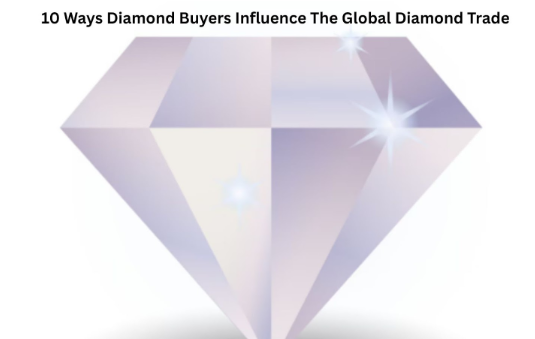10 Ways Diamond Buyers Influence The Global Diamond Trade

Most people never think about it this way, but every time you walk into a jewelry store or scroll through online listings, you hold more power than you realize. Diamonds may look like simple ornaments, shiny little things, but when you buy one, it sets a ripple effect that cuts through borders.
Your choices affect the entire supply chain from mines in Africa to workshops in India to boardrooms in New York. Buyers actually shape an entire industry. When they lean toward one style over another, or when they ask whether their diamond is ethically sourced, the market listens.
Slowly, it shifts to match what they want. That’s power. Here are the ways buyers steer the diamond trade, even if they never thought of themselves as having that kind of reach.
1. Reshape Market Value

Buyers don’t always see diamonds as jewelry. Many see them as something else, an asset. And when many buyers start to chase them, they push the market up.
Suddenly, auctions are breaking records. It all starts with buyers like you deciding diamonds aren’t just shiny ornaments. They’re wealth and a nice way to hold value.
Because diamonds hold value, when you decide to sell them, finding a buyer is easy. In fact, reputable diamond buyers offer these services online. You ship it to them, it gets valued, and you get paid.
2. Create Demand for New Cuts and Styles
You might think your preference doesn’t matter much in the grand scheme of things, but it does. When you lean toward a round brilliant, cutters notice. When you decide an oval or princess cut feels more like you, well, the whole chain starts to shift. Suddenly, those cuts are showing up everywhere.
Even deeper, your choice changes the value of the rough itself. That’s because not every stone can be cut into every shape.
So, let’s say you and a bunch of others start chasing emerald cuts. All of a sudden, those longer pieces of rough jump in value because they’re the only ones that can deliver what you’re after. Without even realizing it, your taste decides what miners dig for, what polishers shape, and what jewellers put their time into.
3. Influence Mining and Supply Chains
You hear about conflict diamonds on the news, and suddenly you start asking questions. Where’s this stone from? Who mined it? And the funny thing is, the moment you ask, the whole industry pays attention.
That’s why you see certifications popping up, or companies talking about blockchain tracking and “responsible sourcing.” Some of them were already trying to do things the right way, sure. But most are only changing because you pushed them into it. Without that pressure, they’d carry on the same way.
4. Push Prices Up or Pull Them Down
The thing with diamonds is, they live and die on demand. If you go after the big stones, the flawless ones, prices shoot up—no surprise there. But if you shrug and decide a smaller or slightly included stone is fine, suddenly the market has to bend to that.
And then there’s the bigger picture. When times are tough—say a recession, or that whole pandemic like COVID-19 hits—buyers pull back. People stop dropping money on luxury, and the value takes a hit.
But during festive seasons, it’s the exact opposite. Suddenly, everyone’s rushing to buy, and just like that, prices climb again.
5. Turn Ethical Sourcing Into a Standard
When buyers hesitate to purchase a stone without knowing its origin, they become part of the reason sellers highlight conflict-free sourcing today. Collectively, buyers pushed the industry to adopt transparency. As concerns grew louder, sellers embraced initiatives like the Kimberley Process, making transparency a priority in the trade.
6. Impact Lives in Mining Countries
When you buy a diamond, your transaction ends at the store, but there’s a whole supply chain behind it. It came from somewhere, and the store will definitely need to restock, which means ordering more.
Your money trickles down to the miners. So, when demand shoots, they enjoy better income that sometimes powers the entire community. The opposite is also true. If buyers move away from it, those same communities can feel the pinch since their economies depend on mining.
7. Steer Jewelry Design Trends
Designers don’t just sit in a studio and dream things up—they monitor trends. When buyers lean toward clean and minimal, they shift to match that. And social media makes shifting trends quick. One person posts a piece that feels fresh, it gets a bit of traction, and before long, you’re seeing it everywhere. What starts as your taste ends up as the trend.
8. Push Lab-Grown Diamonds Into the Mainstream
Lab-grown never used to be a thing. People thought them to be synthetic and not real, so jewellers avoided them. That’s not the case anymore, and a shift in buyers’ perception is the reason. Right now, lab-grown diamonds make up slightly over 10% of the global jewellery market.
How did this happen?
Buyers started asking for something else—stones that were lighter on the wallet, and not tied to messy supply chains. Some buyers prefer synthetic diamonds since they are cheaper than mined ones. For jewelers, this market segment’s demand leaves them no choice but to stock them.
9. Support Fair Trade
Not every diamond comes from some giant corporate mine. A lot of them don’t, actually. Millions of people in mining countries are out there, digging day after day, just trying to survive.
When you go for fair-trade diamonds, you’re not just buying a stone. You’re giving someone on the other side of the world a job, better pay and maybe even something that helps their whole community.
10. Influence How Diamonds Are Marketed
With access to game-changing data, ads are now made around buyers more than ever. Back then, it was all about selling it as a symbol of love.
Now it’s packaged as authenticity, individuality, and responsibility to reflect buyers’ values. Buyers also want something that isn’t just rare but feels like them, and that’s why customization is the norm these days.
Conclusion
Here’s the thing most people miss: your choices matter more than you think. So, while you don’t mine, design or market diamonds, what you want moves it all. From your taste, a style pops up. Your standards push ethics, and how much you are willing to spend determines what’s stocked and the price.
So when you buy a diamond, you’re not just buying a little sparkling stone. You’re shaping how it’s sourced, how it’s sold, how it’s seen. And whether it’s for love, for wealth, or simply because it feels right—you’re the reason the trade keeps running.



